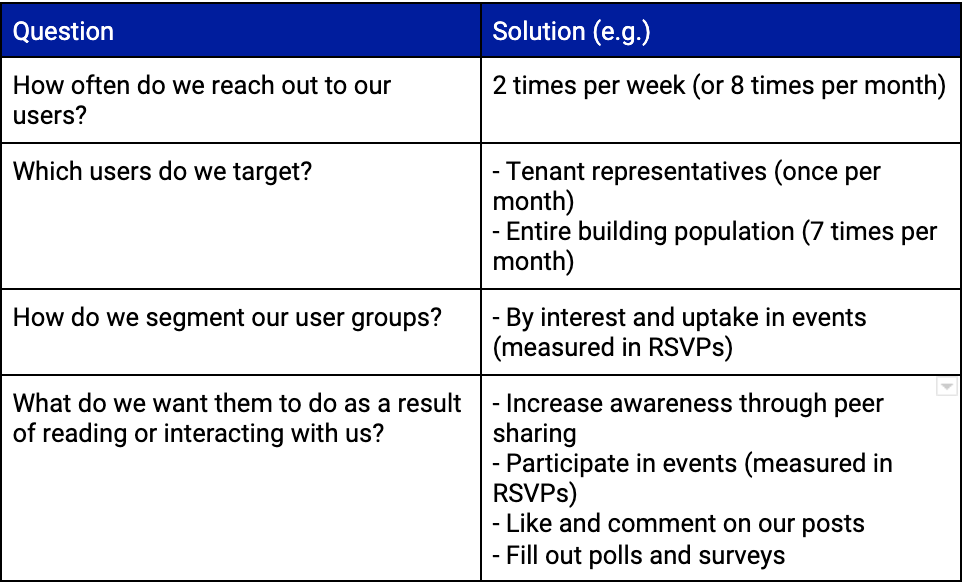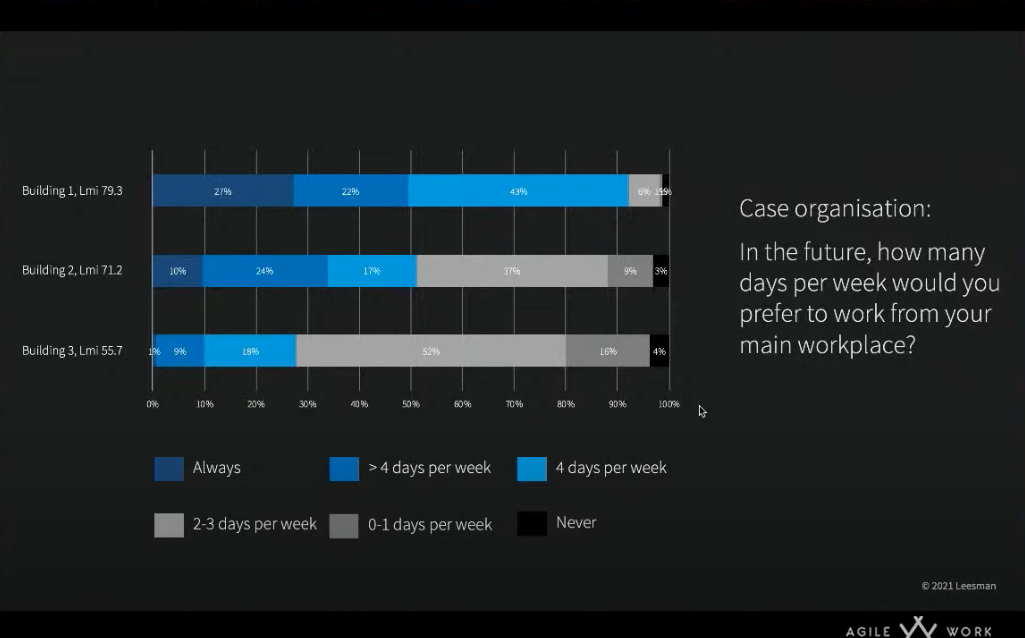1. Streamline your communication processes, from start to finish
This benefit is perhaps the most obvious, but it is also the most fundamental. Without even a haphazard communications plan, you have no consistency and no certainty. The questions of basic outreach become difficult to answer:
- How often do you reach out to your users?
- Which users do you target?
- How do you segment your user groups?
- What do you want them to do as a result of reading or interacting with you?
Perhaps you operate with an ad hoc model — that is, you send the odd email to your tenant representative database when you find a free moment; or can corral a marketing coordinator to do so; or when a critical building update must be relaid. This is an understandable method of operation. And in the old world, it may have sufficed.
Now, you need a better plan. By taking the four questions above and plotting basic answers, you're well on your way to crafting a fully-fledged communication and engagement strategy.
Why is this important? Because planning and routine (i.e. consistent execution) equals speed, autonomy, and simplicity.

Once the plan has been set, the streamlining part is supported by your tenant experience platform (and its attached Content Management System — more on this below). With the right tech, your team will be working from a single calendar, and using complementary workflows that take communication pieces easily from drafts to published posts.
No more time wasted by:
- Manually compiling mailing lists in your email client
- Type-re-typing names, addresses, and personalizing email body content
- Sending word documents back and forth between producers, editors, and approvers
- Deciding how to promote key messages across different platforms (e.g. Slack, WhatsApp, Google Chat, Telegram) in the absence of a unified platform
- Manually tracking and reporting on whatever minimal user data you can scrape from your disparate platforms
- Juggling multiple email clients and CRM solutions
Speed, autonomy, and simplicity equal more time, more money, and the greater potential for meaningful interaction with your users.
"With Equiem's Remote platform, we have been fortunate to have the ability to communicate with all of our tenants, on or off-property - which has been a godsend during these uncertain times. And this is just the start, as we are planning to utilize its impressive capabilities in communicating our return to work plans, smoothing the transition, welcoming our tenants back to their buildings. It's clear that Remote has allowed us to serve and support our tenants at the highest level."
Jimmy Parker
Director of Culture Initiative
Stockdale Capital Partners, LLC
2. Build brand equity
Let's borrow a term from Google and the world of SEO: EAT (or Expertise, Authority, Trust). Google ranks websites based on their ability to satisfy these three qualities. The main method for doing so is content. Content is a powerful vehicle, and its fuel is clear value.
According to marketing powerhouse Hubspot, creating engaging content that is properly targeted to your tenant audience is one of the best ways to cultivate customer loyalty. "All the people who raved about your content and associated all those great feelings to your brand," Hubspot writes, "are very likely to become brand advocates."
How do you create "valuable" content posts and engagement initiatives? It begins with basic research on your tenant community (more on this below). Find out not just what they want, but how you can solve their problems.
A mere office building provides space and amenity, but a trusted brand empowers the individual and improves their working life. This sounds obvious, but many are the brands that discuss only what they care about, or what they think customers care about.
For instance, an owner's brand and content strategy might advance its preference to have office occupancy back at pre-COVID levels. Its content might then ignore the prospect of hybrid working, because it is fundamentally at odds with its brand identity. But if the owner's tenants are leaning toward hybrid working arrangements, the content will not resonate. Owner and tenant do not share a fundamental philosophy. The danger of this situation is obvious.
Here are a few specific examples of how you might show value to customers through the provision of targeted content:
- Communicate with your tenants about your ESG (Environment, Social and Governance) initiatives.
Your tenant experience platform is the perfect place to demonstrate that you care about energy efficiency, for instance, or waste minimization. Tell them about your NABERS Rating and your GRESB certification. Provide clear steps that simplify the process of office-based recycling. Plan community events around global initiatives such as Earth Hour. The tenants of today (and definitely those of tomorrow) make leasing decisions based, in part, on adherence to corporate social responsibility and ESG. If you can prove that you genuinely care with demonstrable work, you will make tenants into loyal brand advocates. Through content and engagement, you chronicle that journey, its challenges and triumphs. - Simplify the daily discovery of critical building information and tenant materials.
Your tenant onboarding kit likely includes a dense, multi-chapter tenant handbook. It will contain all the vital building information tenants need to conduct a successful lease: Deliveries, after-hours access, HVAC, maintenance requests, and so on. By digitizing that information, making it into "living content", and hosting it in a central place (that is, your browser-based tenant experience platform), you are simplifying the process of discovery and compliance by an order of magnitude. Instead of scanning through documents (be they physical or digital), users can simply search for the information they need. And when the time comes to update that information, you need only do it in one place, using one system — no need to issue revised copies to tenant representatives via email.
3. Cultivate a better user experience.
Consider two possible user onboarding journeys.
Journey A is the traditional journey. At the beginning of a lease, you meet with a tenant representative and hand them a physical onboarding package (containing the tenant handbook, among other key materials). You make a plan for a follow-up chat, shake hands, and part ways.
After this initial period, if needed, they must call or email you to discuss any issues they have with their office, or any questions they have about the materials you have provided. Ultimately, any interaction requires a significant investment of time and effort from both parties — and delays are an avoidable side effect.
Journey B is what we like to call the next-generation welcome. At the beginning of a lease, you meet with the tenant representative, just like in Journey A. But instead of tossing an old-school glossy folder in their lap, you show off your tenant experience platform on a big projector screen.
You say: "We're so excited to have you on board. To make the most of your experience here, we've housed all your essential onboarding materials in a special section of your platform. You can search, easily navigate the content categories, and reach out directly to us within moments. That's not all: We've set up a dedicated campaign exclusively for your company — it includes free coffee vouchers, an onboarding competition, and a few other goodies. Have fun!"
It is clear to see which onboarding journey will generate a more favorable first impression of your brand. From there, tenants are easily made into advocates. They see that the tangible quality of your office — the luxurious appointments, the stunning architecture — is congruent with its online equivalent. A community as welcoming as this is difficult to leave.
4. Optimise office occupancy
It is almost certain: Hybrid working, in some form or another, is here to stay. General consensus suggests that global office workers currently prefer a "two day on, three day off" model. On the surface, this means that office occupancy will likely encounter a new ceiling, and that needs for space will dramatically shift.
But maybe not. Consider new research conducted by Leesman, a firm that benchmarks worldwide employee experience, and ranks workplaces on a scale known as the Leesman Index (Lmi). A workplace Lmi is determined by the quality and prevalence of several features: Amenities, services, productivity, and senses of pride and community. The global benchmark compiles responses from 839,688 employees and 5,603 workplaces in 103 countries. We might safely say, based on this sample size, that the findings are reliable.
Here's what they've recently discovered: Workplaces with the highest Lmi scores (known as Leesman+ workplaces) make their employees want to work more days per week in-office. In the chart shown below (credit to Leesman and Agile Work), you can see the following:
- 43% of employees in Building 1 (the building with the highest Lmi) would prefer to work four days per week in-office; 22% would prefer to work more than four days per week in-office; and 27% would want to work in the office always. A staggering 92% of those employees want to work in the office four days per week or more.
- The preferences of employees in Building 3 represent the general consensus laid out at the start of this point. 52% of employees would prefer to work 2-3 days in-office, but only 27% would like to work in-office for four or more days per week.

As you can see, top-tier workplaces have the best chance of courting employees and retaining tenants. It is true that individual companies share part of the responsibility of optimizing the in-office experience, but the owners who can capitalize on these sentiments will thrive in the new hybrid-working world.
Because good communication is inextricable from good customer service, it follows that you cannot hope to attain a high Lmi for your assets without a well-conceived and executed communications strategy. By creating valuable and consistent content and engagement, you foster community, and weave a crucial human element through your technological ecosystem.
5. Capture data to better understand your tenants
The benefits of contextualized data are so numerous that they deserve their own volume (you can download our CRE Landlord's Guide to Tenant App Analytics here).
Suffice it to say this: With a tenant experience platform, you can conduct incentivised large-scale surveys, collect daily polling data, track usage and ask for individual opinions, and more. All of these activities are facilitated by content, and set by your communications strategy. Your strategy (and its objectives) dictates the frequency at which you poll your tenants, and the kinds of questions you ask them.
All of these data points give owners and property managers the ability to predict trends and react to changes within their assets. Here's just one example: Let's say you discover, by analyzing the readership of the content you post, that your tenants prefer stories on ESG or sustainability more than any other theme. Based on this, you can funnel the efforts of your team to produce more of that content.
Why stop there? By cross-referencing readership with the behaviors of a tenancy that will soon be up for renewal, you can equip leasing teams with the insights they need to build a tailored renewal strategy. You can go to that tenant and point to active measures which demonstrate you care about what is important to them. You have something tangible to show for your efforts in building long-term relationships.



